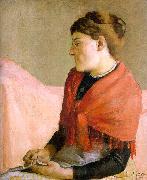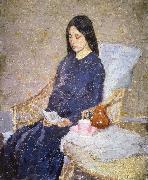Wholesale Oil Painting No Minimum |
|||||||||||
|
|
|||||||||||

|
|||||||||||
|
|
|
||||||||
Ferdinand Hodler1853-1918 Swiss Ferdinand Hodler Galleries Hodler was born in Berne and grew up in poverty. His father, Jean Hodler, made a meager living as a carpenter; his mother, Marguerite (n??e Neukomm), was from a peasant family. By the time Hodler was eight years old, he had lost his father and two younger brothers to tuberculosis. His mother remarried to a decorative painter, but in 1867 she too died of tuberculosis. Before he was ten, Hodler received training in decorative painting from his stepfather, and was subsequently sent to Thun to apprentice with a local painter, Ferdinand Sommer. Hodler's earliest works were conventional landscapes, which he sold in shops and to tourists. In 1871, at the age of 18, he traveled on foot to Geneva to start a career as a painter. The works of Hodler's early maturity consisted of landscapes, figure compositions and portraits, treated with a vigorous realism. He made a trip to Basel in 1875, where he studied the paintings of Hans Holbein??especially Dead Christ in the Tomb, which influenced Hodler's many treatments of the theme of death. In the last decade of the 19th century his work evolved to combine influences from several genres including symbolism and art nouveau. He developed a style which he called Parallelism, characterized by groupings of figures symmetrically arranged in poses suggesting ritual or dance. In 1884 Hodler met Augustine Dupin (1852?C1909), who became his companion and model for the next several years. Their son, Hector Hodler, was born in 1887. In 1889 Hodler married Bertha Stucki; they were divorced in 1891. Hodler's work in his final phase took on an expressionist aspect with strongly coloured and geometrical figures. Landscapes were pared down to essentials, sometimes consisting of a jagged wedge of land between water and sky. However, the most famous of Hodler's paintings portray scenes in which characters are engaged in everyday activities, such as the famous woodcutter (Der Holzfaller, Mus??e d'Orsay, Paris). This picture went on to appear on the back of the 50 Swiss Franc bank note issued by the Swiss National Bank. In 1898, Hodler married Berthe Jacques. In 1914 he condemned the German atrocities conducted using artillery at Rheims. In retaliation for this, German art museums excluded Hodler's work. In 1908 he met Valentine Gode-Darel, who became his mistress. She was diagnosed with cancer in 1913, and the many hours Hodler spent by her bedside resulted in a remarkable series of paintings documenting her disintegration. Her death in January 1915 affected Hodler greatly. He occupied himself with work; a series of about 20 introspective self-portraits date from 1916. By late 1917 his declining health led him to thoughts of suicide. He died on May 19, 1918 in Geneva leaving behind a number of unfinished works portraying the city. |
||||||||
|
|
||||||||
The Convalescent
The Convalescent Painting ID:: 2332 |
1880
Oskar Reinhart Foundation, Winterthur 1880 Oskar Reinhart Foundation, Winterthur |
|||||||
|
|
||||||||
Gwen JohnWelsh 1876-1939 Gwen John was born in Haverfordwest, Wales, the second of four children of Edwin William John and his wife Augusta (nee Smith). Edwin John was a solicitor whose dour temperament cast a chill over his family, and Augusta was often absent from the children due to ill health, leaving her two sisters??stern Salvationists??to take her place in the household. Despite the considerable tension in the family (who became known as "those turbulent Johns") the children's interest in literature and art was encouraged. Following the mother??s premature death in 1884, the family moved to Tenby in Pembrokeshire, Wales. Although she painted and drew from an early age, her earliest surviving work dates from her nineteenth year. From 1895?C98, she studied at the Slade School of Art, where her younger brother, Augustus John, had begun his studies in 1894. During this period they shared living quarters, and further reduced their expenses by subsisting on a diet of nuts and fruit. Even as a student, Augustus' brilliant draughtsmanship and personal glamour made him a celebrity, and stood in contrast to Gwen's quieter gifts and reticent demeanour. While he greatly admired her art, Augustus offered her advice which she ignored; he urged her to take a "more athletic attitude to life", and cautioned her against what he saw as the "unbecoming and unhygienic negligence" of her mode of living, but her entire life was marked by a disregard for her physical well-being. In 1898 she made her first visit to Paris with two friends from the Slade, and while there she studied under James McNeill Whistler at the Academie Carmen. She returned to London in 1899, and spent the next four years in austere circumstances. When she exhibited her work for the first time in 1900, at the New English Art Club (NEAC), her address was a derelict building where she was living illegally. |
||||||||
|
|
||||||||
|
|
The Convalescent
The Convalescent Painting ID:: 41566 |
mk164
1923-24
Fitzwilliam Museum
mk164 1923-24 Fitzwilliam Museum |
||||||
|
|
||||||||
|
Gwen John Welsh 1876-1939 Gwen John was born in Haverfordwest, Wales, the second of four children of Edwin William John and his wife Augusta (nee Smith). Edwin John was a solicitor whose dour temperament cast a chill over his family, and Augusta was often absent from the children due to ill health, leaving her two sisters??stern Salvationists??to take her place in the household. Despite the considerable tension in the family (who became known as "those turbulent Johns") the children's interest in literature and art was encouraged. Following the mother??s premature death in 1884, the family moved to Tenby in Pembrokeshire, Wales. Although she painted and drew from an early age, her earliest surviving work dates from her nineteenth year. From 1895?C98, she studied at the Slade School of Art, where her younger brother, Augustus John, had begun his studies in 1894. During this period they shared living quarters, and further reduced their expenses by subsisting on a diet of nuts and fruit. Even as a student, Augustus' brilliant draughtsmanship and personal glamour made him a celebrity, and stood in contrast to Gwen's quieter gifts and reticent demeanour. While he greatly admired her art, Augustus offered her advice which she ignored; he urged her to take a "more athletic attitude to life", and cautioned her against what he saw as the "unbecoming and unhygienic negligence" of her mode of living, but her entire life was marked by a disregard for her physical well-being. In 1898 she made her first visit to Paris with two friends from the Slade, and while there she studied under James McNeill Whistler at the Academie Carmen. She returned to London in 1899, and spent the next four years in austere circumstances. When she exhibited her work for the first time in 1900, at the New English Art Club (NEAC), her address was a derelict building where she was living illegally. The Convalescent mk164 1923-24 Fitzwilliam Museum |
||||||||
|
|
||||||||
|
Prev Next
|
||||||||
|
|
||||||||
|
Related Paintings to Gwen John :. |
||||||||
|
|
||||||||
|
CONTACT US |


